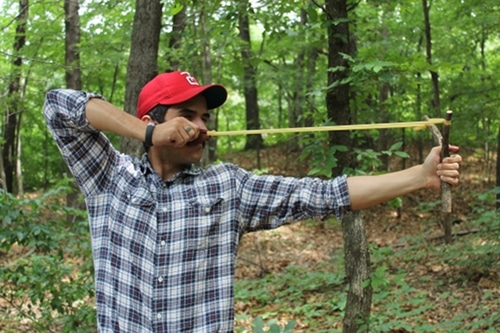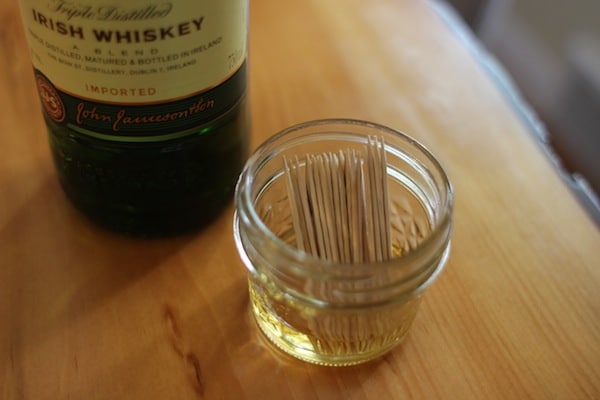
Imagine the idealized rough and tumble boy depicted in literature, movies, and TV shows. Go ahead. Do it. Done? Whether you imagined Tom Sawyer, Dennis the Menace, or Bart Simpson, chances are you pictured him with a handmade slingshot dangling from his back pants pocket.
The humble slingshot has been a fixture among boys across cultures and across generations. The first modern-type slingshots probably didn’t make an appearance until vulcanized rubber was invented in 1839. 19th century boys used old rubber tire inner tubes as the bands to catapult their rocks and pellets at cans and unsuspecting cats.

The slingshot was the first product WHAM-O made, and it gave the company its memorable name. “WHAM-O” was the sound the slingshot’s projectile made when it hit its target.
The popularity of the slingshot really took off though after WWII and commercially-made slingshots became widely available. While we typically associate slingshots with bucktoothed, freckled-faced boys, placed in the hands of a skilled user, a slingshot can become an efficient hunting tool and even a guerrilla warrior weapon, and 80% of slingshot sales in the post-war period were to adult men, who used the slingshot for hunting and also took part in emerging slingshot clubs and competitions.
Manufactured slingshots are still available today, but, because they require very few materials and tools to make, slingshots were and are the perfect toy/weapon to make yourself. There are hundreds of variations and tweaks you can try when crafting your own slingshot, but today we’re going to show you how to make the old classic natural fork variety. Whether you’re making it for yourself or for your kid, this is a great weekend project that takes only about 60 minutes to complete and will provide hours upon hours of entertainment for you and your family.
Materials & Tools Needed
Materials
- A Y-shaped tree branch with at least a 30 degree fork
- 1/4″ latex surgical tubing (available at Home Depot)
- Leather strips
- Dental floss
Tools
- Saw
- Knife
- Awl (optional)
- About an hour
Step 1: Find Your Fork
The first step in making a natural fork slingshot is finding a Y-shaped tree branch with an adequate natural fork. Look for hardwoods like oak, ash, dogwood, hickory, and (hard) maple. Buckthorn bush, an invasive plant, creates some good solid Y-shaped branches too, and the wood is pretty strong.
Don’t worry if you can’t find the perfect Y-shaped frame. Chances are, you’re not going to find it. As long as the fork forms at least a 30 degree angle, you’re good to go.
Sometimes you can find branches lying on the ground, but if there’s a dearth of grounded tree limbs, you’ll need to cut one off a tree. I’ve got a bunch of oak trees in my front and backyards, so I strolled around with my saw in tow looking at the low-hanging branches for my fork. I chanced upon this beauty below:

Jackpot!

I used my handy dandy bow saw to cut down the limb. Cut your handle longer than you think you’ll need. You can always shorten it later; lengthening it won’t be an option.

Time to trim some branches off until I am left with an unadorned “Y” shape.

Leave more of the fork than you think you’ll need. Again, you can always shorten later.

Basic slingshot frame.
Step 2: Dry Your Wood
Branches that have just been cut from trees will have a lot of moisture in them which gives them a bit of flexibility. That’s not good for a slingshot frame. We want something that won’t bend while you’re pulling back on the bands. So we need to suck all that moisture out of the wood.
The natural way would be to just set the branch somewhere and let it dry out for a year. Since we want to finish this project in a weekend, that’s a not a good option. A faster natural drying method would be to start a campfire and set your branch near the flames. As soon as you hear your fork stop hissing, you’ll know the water is all out of it. While certainly faster, this method will still take hours or even a day before the fork is completely dry.
To keep your slingshot project under an hour, we’re going to utilize a bit of space age technology: your kitchen microwave.

Place your fork on top of a rag.

Wrap it up like a babe in swaddling clothes. This will protect your microwave.

Unlike what you should do with a babe in swaddling clothes, place the wrapped fork in the microwave.

You need to take it slow with drying your fork. Don’t just set the microwave on high for 10 minutes while you go swing some Indian clubs. Your wood will catch fire (this happened to my first slingshot). Rather, microwave it on high in 30 second bursts and let it rest for about a minute in-between each shot. Keep repeating until your wood stops hissing. Mine took six, thirty second zaps to completely dry.
Step 3: Carve Notches in Your Fork

With your wood dry, we can now carve the notches where our bands will go. Create one notch on each of your fork’s “prongs” at roughly the same height.

Finished notches.

I had a lot of extra wood on top of my notch, so I sawed them down a bit using my table saw. Make sure to leave a bit of wood above your notch or else your band will slip off your frame when you fire it.
Step 4: Cut Your Tubing

Eyeball how long you want your tubing to be. Remember, the shorter it is, the more oomph you’ll have in your shots. If the bands are too short, though, you won’t be able to pull them back. Once you have your length, double the band and cut it in half into two equal length pieces like so.
Step 5: Attach Tubing to Fork

Wrap one end of the tubing around your notch so that it doubles back on itself like in the photo. Tie the end of the tube to the rest of the tube with some dental floss. Wrap the dental floss as tight as you can, tie it off, and cut off any long ends. Repeat on the other side.
Step 6: Create Pouch

I bought a strip of leather at Hobby Lobby for $2. Cut a rectangle that’s about four inches wide and two inches high.

Create a long octagon shape by cutting off the corners on your rectangular leather strip.

Create two holes at each of the longest ends of your leather strip. Your tubing will attach here. I just used my knife, but you can use an awl or some other puncturing tool.
Step 7: Attach Pouch to Tubing

Slide tube ends through holes, like so.

Similar to how you attached the tube to the frame, fold the end of the tube back on itself and tie it off tightly with some dental floss.
Have Fun!

Have fun with your homemade natural fork slingshot. This bad boy shoots pretty dang accurate and far. I was able to plink a tree trunk with a stone from about 30 yards.
You may have to adjust the length of your bands so that you get the right amount of force. The latex bands will degrade after extended use. Replace them as soon as you see any wear and tear. The last thing you want is a band to snap and smack you in the eye.
It goes without saying, but be smart and safe when you or your kid play with a slingshot. At the end of the day, a slingshot is a small weapon that hurls projectiles at fast speeds.
Before you try your hand at hunting squirrels or other small varmints with your slingshot, check your local hunting laws to see if hunting with slingshots is permissible and if it requires a license.

Tin cans don’t stand a chance against my trusty handmade slingshot.
Further Reading
In researching this post I was surprised to discover that there’s a vibrant and extremely helpful community of slingshot enthusiasts out there. If you’re interested in learning more advanced slingshot making techniques, I highly recommend you check the following websites:
Slingshot Forum. This place is amazing. Lots of useful guides and friendly folks to answer all your slingshot questions.
The Slingshots Page. Don’t let the rough and simple web design of this site fool you. It’s packed with some fantastic advice on making your own slingshot. The most useful sections are on how to attach your bands to the fork and how to attach your pouch to the bands.







